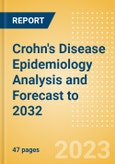Men and women can both be affected, and the disease can occur at any age, but CD is more prevalent among women and in the young age population. Diet and stress may aggravate CD, but do not cause the disease. Recent research suggests hereditary, genetic, and environmental factors contribute to the development of CD (National Health Service, 2021a). Crohn's disease can be both painful and debilitating, and sometimes may lead to life-threatening complications (Mayo Clinic, 2022). Inflammation in CD can result in severe scarring and narrowing of parts of the bowel. There's no known cure for Crohn's disease, but therapies can greatly reduce its signs and symptoms and even bring about long-term remission and healing of inflammation. With treatment, many people with Crohn's disease can function well (National Health Service, 2021a; Mayo Clinic, 2022).
In the 8MM, the diagnosed incident cases of CD are expected to increase from 118,885 cases in 2022 to 122,175 cases in 2032, at an annual growth rate (AGR) of 0.28%. In 2032, the US will have the highest number of diagnosed incident cases of CD in the 8MM, with 68,815 cases, and France will have the fewest diagnosed incident cases of CD with 4,560 cases. Globaldata epidemiologists attribute the increase in the diagnosed incident cases of CD to changes in population dynamics in each market.
In the 8MM, the diagnosed prevalent cases of CD are expected to increase from 1,626,752 cases in 2022 to 1,695,580 cases in 2032, at an AGR of 0.42%. In 2032, the US will have the highest number of diagnosed prevalent cases of CD in the 8MM, with 755,802 cases, and Japan will have the fewest diagnosed prevalent cases of CD with 44,732 cases. Globaldata epidemiologists attribute the increase in the diagnosed prevalent cases of CD to changes in population dynamics in each market.
Scope
This report provides an overview of the risk factors, comorbidities, and the global and historical epidemiological trends for CD in the eight major markets (8MM: US, France, Germany, Italy, Spain, UK, Japan, and Canada). The report includes a 10-year epidemiology forecast for the diagnosed incident cases and diagnosed prevalent cases of CD. The diagnosed incident cases and diagnosed prevalent cases of CD are segmented by age (for all ages in 10-year age groups for ages 0-9 years up to 80 years and older), and sex. The report also provides the diagnosed prevalent cases of fistulizing CD as well as diagnosed prevalent cases of CD in remission in each of the severity segments. This epidemiology forecast for CD is supported by historical data obtained from peer-reviewed articles and population-based studies. The forecast methodology was kept consistent across the 8MM to allow for a meaningful comparison of the forecast incident and prevalent cases of CD across these markets.Reasons to Buy
The CD epidemiology series will allow you to:
- Develop business strategies by understanding the trends shaping and driving the global CD market.
- Quantify patient populations in the global CD market to improve product design, pricing, and launch plans.
- Organize sales and marketing efforts by identifying the age groups that present the best opportunities for CD therapeutics in each of the markets covered.








